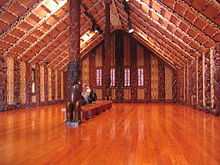Tukutuku (artwork)
Tukutuku is a decorative wickerwork made of various materials that is used as wall paneling in the wharenui (meeting houses) of the Māori in New Zealand .
history
Little is known about the origins, manufacture and use of the tukutuku in pre-European times. The known testimonies all come from the time after the Europeans came to New Zealand and influenced the Māori culture . That the Tukutuku art comes from Polynesian ancestors is speculative and cannot be proven.
The first references to the handicraft came from the French navigator and lieutenant of Le Mascarin , Saint Jean Roux , who wrote descriptions of a house during a visit to New Zealand in 1772, in which the Tukutuku elements of the house were mentioned. The first notes and illustrations were made by the missionary Richard Taylor in 1839 and the English draftsman George French Angas in 1844. Peter Henry Buck tried to describe some pre-European designs in 1921, but could not place them in time. Essentially, only the works of art that were created in the period after the European settlement of New Zealand remain to be viewed. There is no doubt that the Europeans influenced the art of the Māori . There were, for example, between the years 1910 and 1930 the change that pattern of Tukutuku to paint -Vertäfelung, which has not prevailed. From around 1880 for two decades, the paneling was also attached to the back wall of the veranda on the entrance side, which was also not very popular. From 1900 motifs that did not have Māori origins found their way into some parts. For a few decades, efforts have been made to return to tradition and origins, which are sometimes interpreted differently.
Manufacturing
The basis of every Tukutuku element of the wall cladding is a latticework created from longitudinal and cross bars. The vertical bars at the back are made of Toetoe-Kākaho (Cortaderia toetoe), the stems of a New Zealand pampas grass , while the thin crossbars are made of wood. The underlying latticework is cross-stitched with bleached Kiekie stripes ( Freycinetia banksii ) for the color white and Pīngao (Ficinia spiralis), an endemic beach grass-like plant, for the color gold / orange. Other colors are possible. The cross-stitch connections that connect the vertical bars to the crossbars create a square basic shape. Depending on the use of the differently colored plant strips, different geometric patterns can be created on the basis of the square basic shape.
While the wood carvings were made exclusively by men, the weaving of the TukuTuku elements was similar to the weaving task of women. But men could also become experts in this art.
use
The Tukutuku elements are placed on the inner walls of the meeting houses ( Wharenui ) between the carved wood paneling. The differently used patterns, which turn out quite different from Iwi (tribe) to Iwi , all have their special symbolic meanings, which are partly of mythological origin and partly to do with their ancestors.
literature
- Roger Neich : Painted Histories . Early Maori Figurative Painting . Auckland University Press , Auckland 1993, ISBN 1-86940-087-9 (English).
Web links
- Tukutuku Tuturu Maori . (PDF 418 kB)Auckland Museum, 1997,accessed on March 24, 2016(English).
- Pūawaitanga o te Ringa - Fruits of our busy hands - Stories of the Tukutuku Patterns . Christchurch City Libraries,accessed March 24, 2016.
- Kahutoi Te Kanawa : Māori weaving and tukutuku - te raranga me te whatu - Tāniko and tukutuku . Te Ara - the Encyclopedia of New Zealand , October 15, 2014, accessed March 24, 2016 .
Individual evidence
- ↑ a b c neich : Painted Histories . 1993, p. 99 .
- ^ Peter Henry Buck : Maori Decorative Art: No. 1, House panels ( Arapaki, Tuitui , or Tukutuku ). In: Transaction and Proceedings of the New Zealand Institute . Volume 53 . New Zealand Institute , Wellington 1921, pp. 452-470 (English, online [accessed March 24, 2016]).
- ↑ neich : Painted Histories . 1993, p. 119 .
- ↑ Toetoe . Landcare Research , accessed March 24, 2016 .
- ↑ Kiekie . Landcare Research , accessed March 24, 2016 .
- ↑ Pīngao . Landcare Research , accessed March 24, 2016 .
- ↑ a b Tukutuku Tuturu Maori . Auckland Museum , 1997, accessed March 24, 2016 .
- ^ Joan Metge : The Maoris of New Zealand Rautahi . Routledge & Kegan Paul , London 1976, ISBN 0-7100-8352-1 , pp. 273 (English).
- ↑ Pūawaitanga o te Ringa - Fruits of our busy hands - Stories of the Tukutuku Patterns . Christchurch City Libraries , accessed March 24, 2016 .

